sensor CHRYSLER TOWN AND COUNTRY 2008 5.G Owners Manual
[x] Cancel search | Manufacturer: CHRYSLER, Model Year: 2008, Model line: TOWN AND COUNTRY, Model: CHRYSLER TOWN AND COUNTRY 2008 5.GPages: 531, PDF Size: 4.51 MB
Page 12 of 531
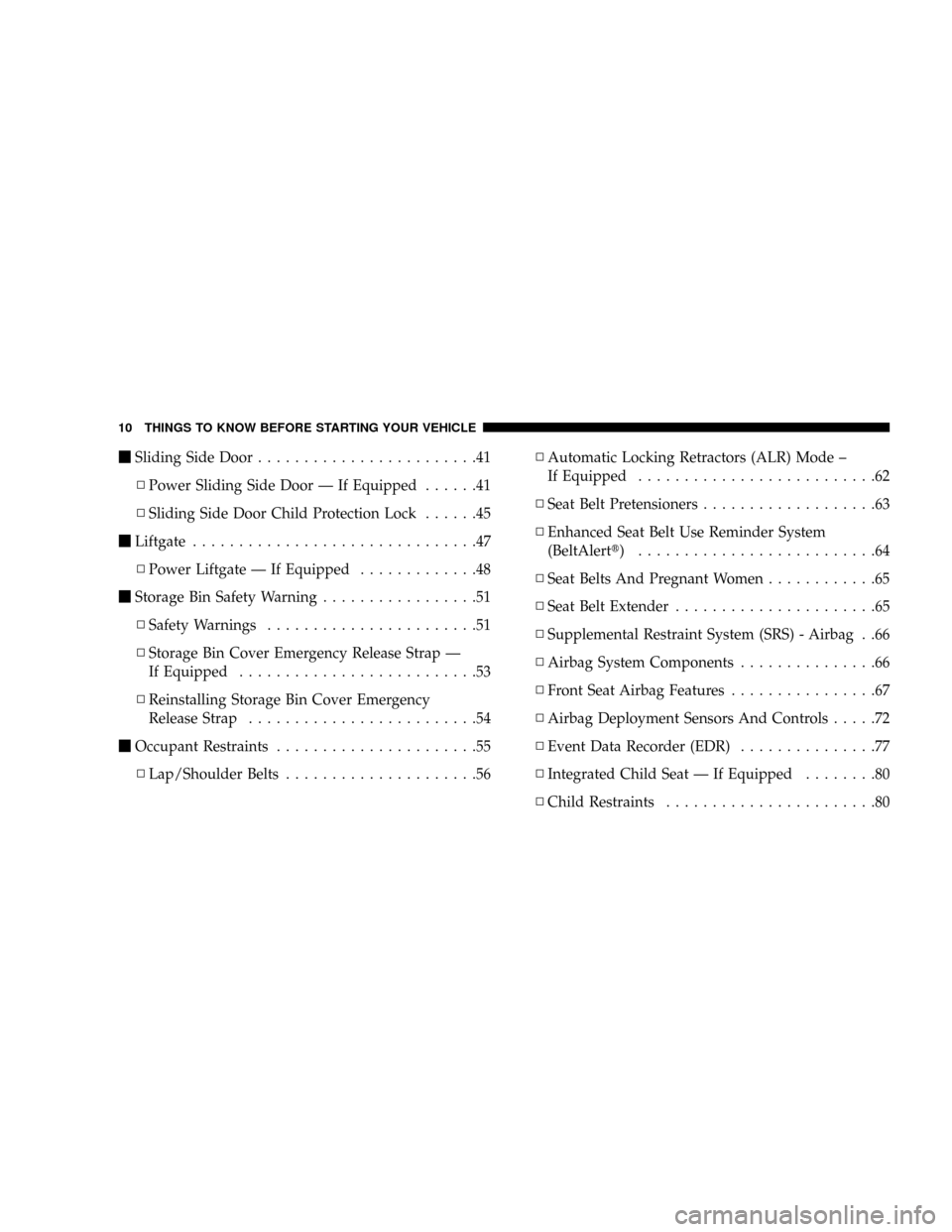
mSliding Side Door........................41
NPower Sliding Side Door Ð If Equipped......41
NSliding Side Door Child Protection Lock......45
mLiftgate...............................47
NPower Liftgate Ð If Equipped.............48
mStorage Bin Safety Warning.................51
NSafety Warnings.......................51
NStorage Bin Cover Emergency Release Strap Ð
If Equipped..........................53
NReinstalling Storage Bin Cover Emergency
Release Strap.........................54
mOccupant Restraints......................55
NLap/Shoulder Belts.....................56NAutomatic Locking Retractors (ALR) Mode ±
If Equipped..........................62
NSeat Belt Pretensioners...................63
NEnhanced Seat Belt Use Reminder System
(BeltAlertt) ..........................64
NSeat Belts And Pregnant Women............65
NSeat Belt Extender......................65
NSupplemental Restraint System (SRS) - Airbag . .66
NAirbag System Components...............66
NFront Seat Airbag Features................67
NAirbag Deployment Sensors And Controls.....72
NEvent Data Recorder (EDR)...............77
NIntegrated Child Seat Ð If Equipped........80
NChild Restraints.......................80
10 THINGS TO KNOW BEFORE STARTING YOUR VEHICLE
Page 52 of 531
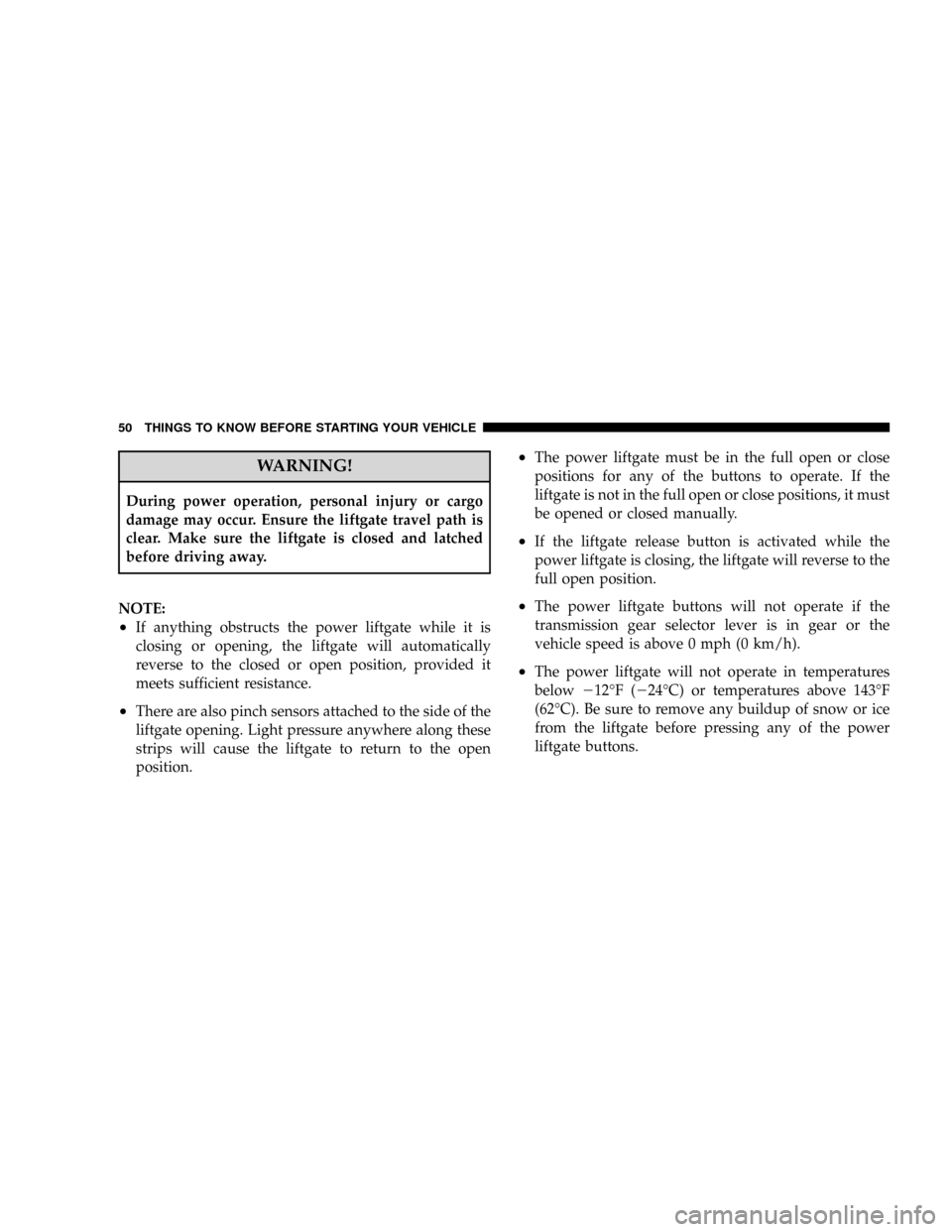
WARNING!
During power operation, personal injury or cargo
damage may occur. Ensure the liftgate travel path is
clear. Make sure the liftgate is closed and latched
before driving away.
NOTE:
²If anything obstructs the power liftgate while it is
closing or opening, the liftgate will automatically
reverse to the closed or open position, provided it
meets sufficient resistance.
²There are also pinch sensors attached to the side of the
liftgate opening. Light pressure anywhere along these
strips will cause the liftgate to return to the open
position.
²The power liftgate must be in the full open or close
positions for any of the buttons to operate. If the
liftgate is not in the full open or close positions, it must
be opened or closed manually.
²If the liftgate release button is activated while the
power liftgate is closing, the liftgate will reverse to the
full open position.
²The power liftgate buttons will not operate if the
transmission gear selector lever is in gear or the
vehicle speed is above 0 mph (0 km/h).
²The power liftgate will not operate in temperatures
below212ÉF (224ÉC) or temperatures above 143ÉF
(62ÉC). Be sure to remove any buildup of snow or ice
from the liftgate before pressing any of the power
liftgate buttons.
50 THINGS TO KNOW BEFORE STARTING YOUR VEHICLE
Page 68 of 531
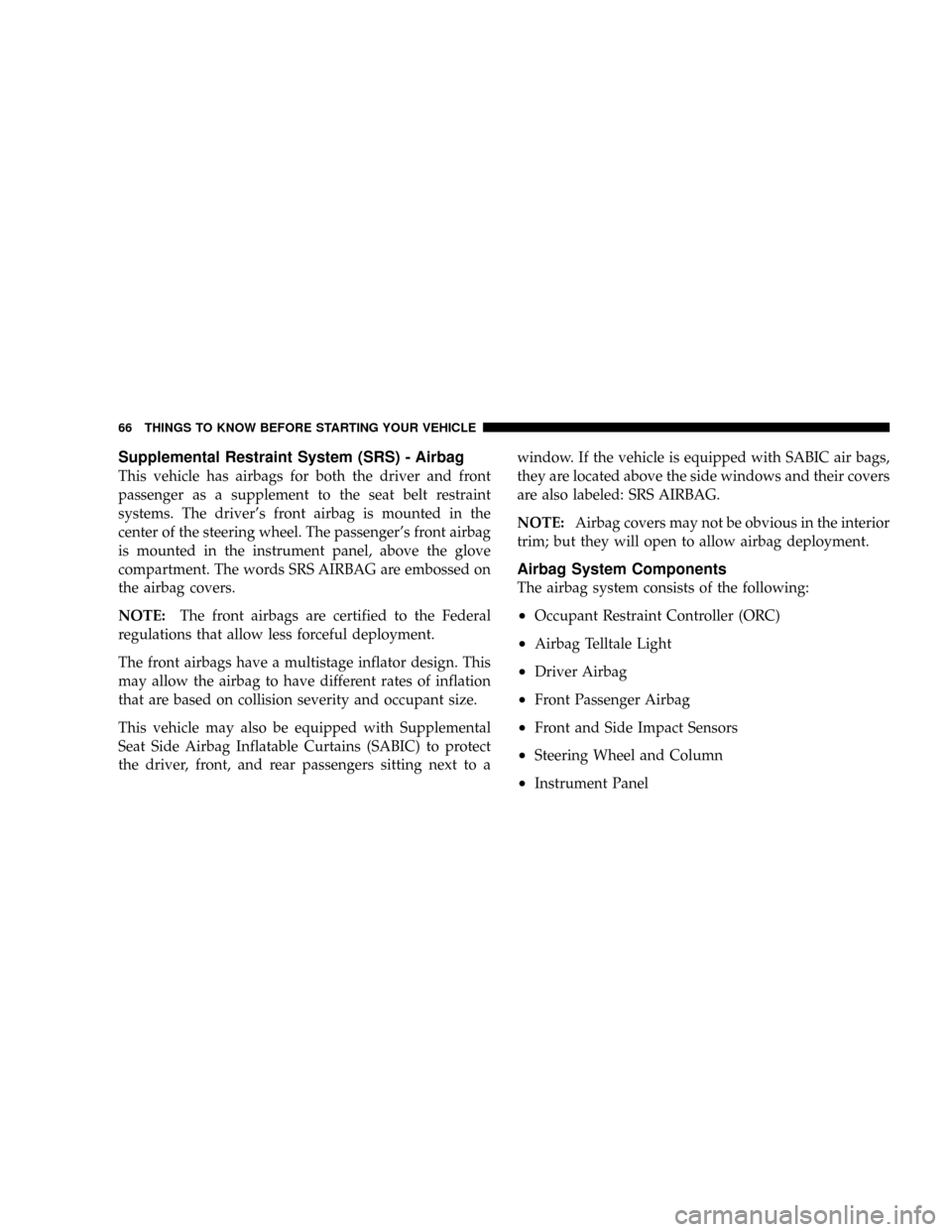
Supplemental Restraint System (SRS) - Airbag
This vehicle has airbags for both the driver and front
passenger as a supplement to the seat belt restraint
systems. The driver's front airbag is mounted in the
center of the steering wheel. The passenger's front airbag
is mounted in the instrument panel, above the glove
compartment. The words SRS AIRBAG are embossed on
the airbag covers.
NOTE:The front airbags are certified to the Federal
regulations that allow less forceful deployment.
The front airbags have a multistage inflator design. This
may allow the airbag to have different rates of inflation
that are based on collision severity and occupant size.
This vehicle may also be equipped with Supplemental
Seat Side Airbag Inflatable Curtains (SABIC) to protect
the driver, front, and rear passengers sitting next to awindow. If the vehicle is equipped with SABIC air bags,
they are located above the side windows and their covers
are also labeled: SRS AIRBAG.
NOTE:Airbag covers may not be obvious in the interior
trim; but they will open to allow airbag deployment.
Airbag System Components
The airbag system consists of the following:
²Occupant Restraint Controller (ORC)
²Airbag Telltale Light
²Driver Airbag
²Front Passenger Airbag
²Front and Side Impact Sensors
²Steering Wheel and Column
²Instrument Panel
66 THINGS TO KNOW BEFORE STARTING YOUR VEHICLE
Page 69 of 531
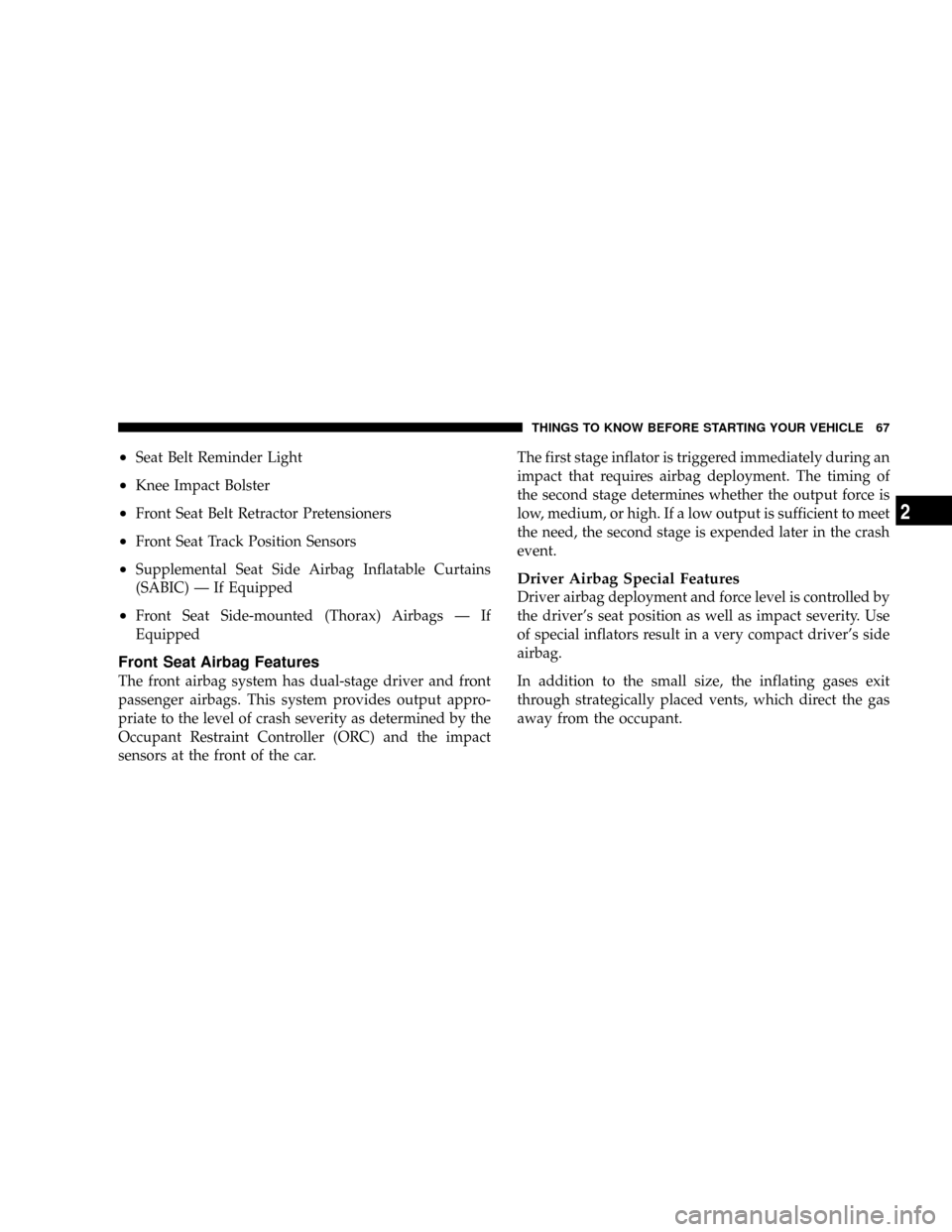
²Seat Belt Reminder Light
²Knee Impact Bolster
²Front Seat Belt Retractor Pretensioners
²Front Seat Track Position Sensors
²Supplemental Seat Side Airbag Inflatable Curtains
(SABIC) Ð If Equipped
²Front Seat Side-mounted (Thorax) Airbags Ð If
Equipped
Front Seat Airbag Features
The front airbag system has dual-stage driver and front
passenger airbags. This system provides output appro-
priate to the level of crash severity as determined by the
Occupant Restraint Controller (ORC) and the impact
sensors at the front of the car.The first stage inflator is triggered immediately during an
impact that requires airbag deployment. The timing of
the second stage determines whether the output force is
low, medium, or high. If a low output is sufficient to meet
the need, the second stage is expended later in the crash
event.
Driver Airbag Special Features
Driver airbag deployment and force level is controlled by
the driver's seat position as well as impact severity. Use
of special inflators result in a very compact driver's side
airbag.
In addition to the small size, the inflating gases exit
through strategically placed vents, which direct the gas
away from the occupant.
THINGS TO KNOW BEFORE STARTING YOUR VEHICLE 67
2
Page 71 of 531
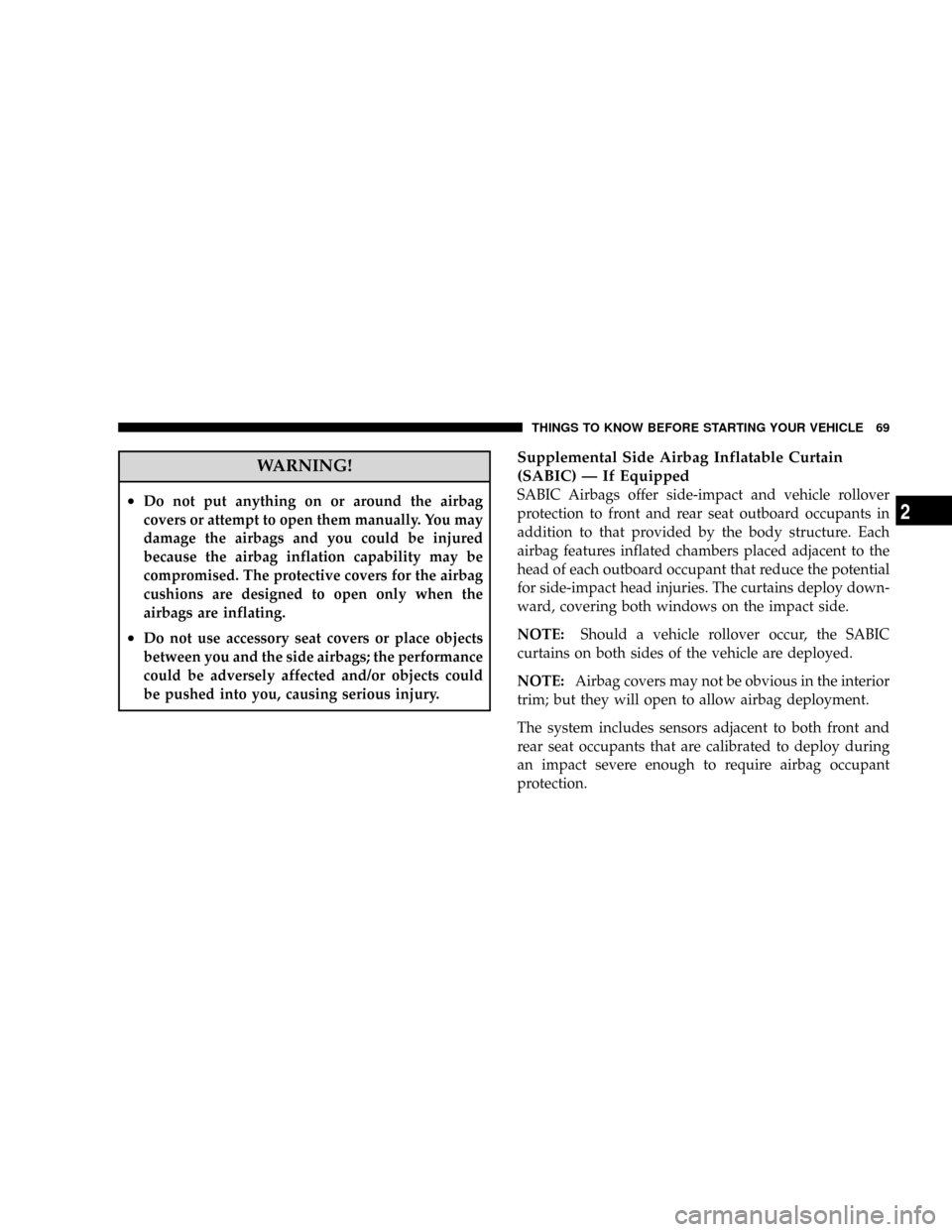
WARNING!
²Do not put anything on or around the airbag
covers or attempt to open them manually. You may
damage the airbags and you could be injured
because the airbag inflation capability may be
compromised. The protective covers for the airbag
cushions are designed to open only when the
airbags are inflating.
²Do not use accessory seat covers or place objects
between you and the side airbags; the performance
could be adversely affected and/or objects could
be pushed into you, causing serious injury.
Supplemental Side Airbag Inflatable Curtain
(SABIC) Ð If Equipped
SABIC Airbags offer side-impact and vehicle rollover
protection to front and rear seat outboard occupants in
addition to that provided by the body structure. Each
airbag features inflated chambers placed adjacent to the
head of each outboard occupant that reduce the potential
for side-impact head injuries. The curtains deploy down-
ward, covering both windows on the impact side.
NOTE:Should a vehicle rollover occur, the SABIC
curtains on both sides of the vehicle are deployed.
NOTE:Airbag covers may not be obvious in the interior
trim; but they will open to allow airbag deployment.
The system includes sensors adjacent to both front and
rear seat occupants that are calibrated to deploy during
an impact severe enough to require airbag occupant
protection.
THINGS TO KNOW BEFORE STARTING YOUR VEHICLE 69
2
Page 74 of 531
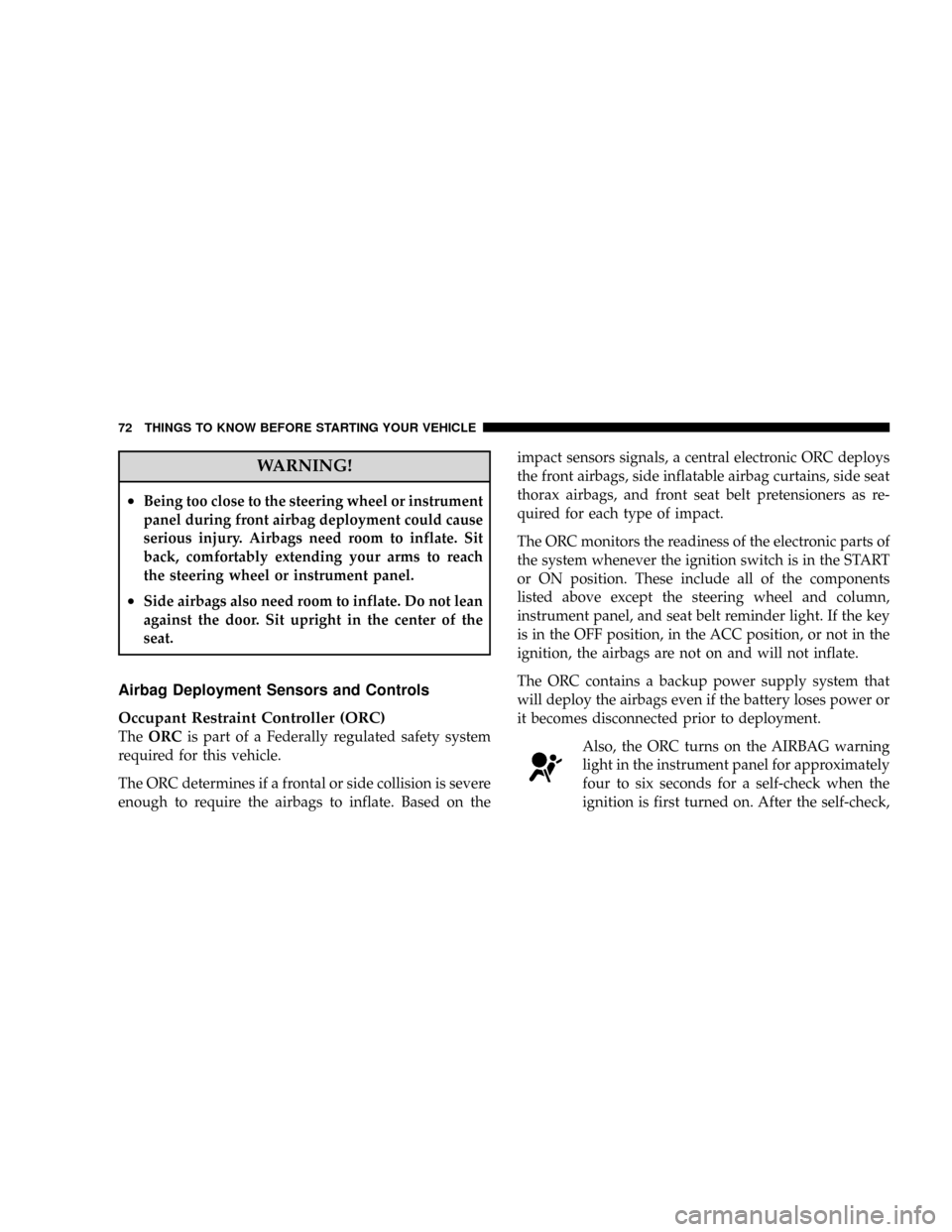
WARNING!
²Being too close to the steering wheel or instrument
panel during front airbag deployment could cause
serious injury. Airbags need room to inflate. Sit
back, comfortably extending your arms to reach
the steering wheel or instrument panel.
²Side airbags also need room to inflate. Do not lean
against the door. Sit upright in the center of the
seat.
Airbag Deployment Sensors and Controls
Occupant Restraint Controller (ORC)
TheORCis part of a Federally regulated safety system
required for this vehicle.
The ORC determines if a frontal or side collision is severe
enough to require the airbags to inflate. Based on theimpact sensors signals, a central electronic ORC deploys
the front airbags, side inflatable airbag curtains, side seat
thorax airbags, and front seat belt pretensioners as re-
quired for each type of impact.
The ORC monitors the readiness of the electronic parts of
the system whenever the ignition switch is in the START
or ON position. These include all of the components
listed above except the steering wheel and column,
instrument panel, and seat belt reminder light. If the key
is in the OFF position, in the ACC position, or not in the
ignition, the airbags are not on and will not inflate.
The ORC contains a backup power supply system that
will deploy the airbags even if the battery loses power or
it becomes disconnected prior to deployment.
Also, the ORC turns on the AIRBAG warning
light in the instrument panel for approximately
four to six seconds for a self-check when the
ignition is first turned on. After the self-check,
72 THINGS TO KNOW BEFORE STARTING YOUR VEHICLE
Page 75 of 531
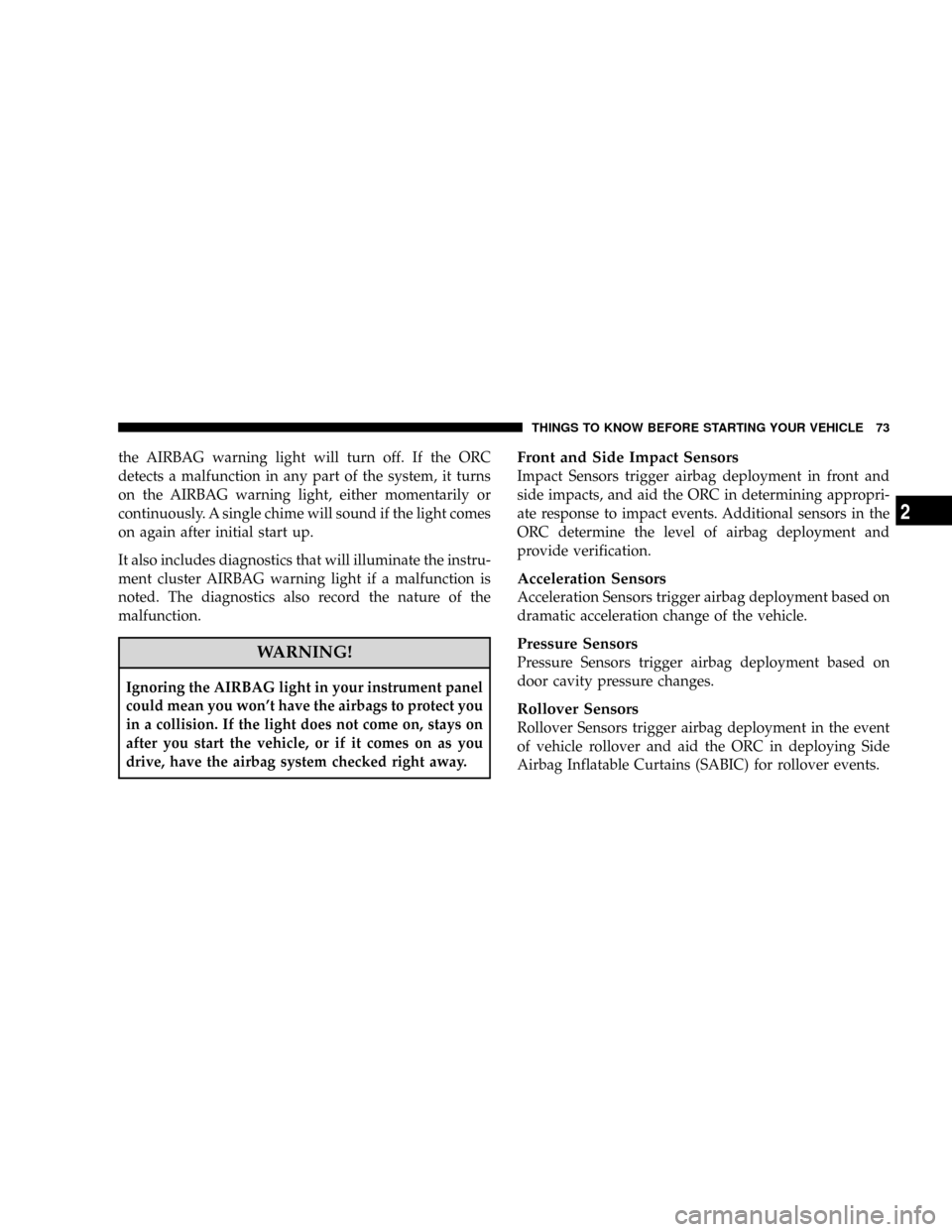
the AIRBAG warning light will turn off. If the ORC
detects a malfunction in any part of the system, it turns
on the AIRBAG warning light, either momentarily or
continuously. A single chime will sound if the light comes
on again after initial start up.
It also includes diagnostics that will illuminate the instru-
ment cluster AIRBAG warning light if a malfunction is
noted. The diagnostics also record the nature of the
malfunction.
WARNING!
Ignoring the AIRBAG light in your instrument panel
could mean you won't have the airbags to protect you
in a collision. If the light does not come on, stays on
after you start the vehicle, or if it comes on as you
drive, have the airbag system checked right away.
Front and Side Impact Sensors
Impact Sensors trigger airbag deployment in front and
side impacts, and aid the ORC in determining appropri-
ate response to impact events. Additional sensors in the
ORC determine the level of airbag deployment and
provide verification.
Acceleration Sensors
Acceleration Sensors trigger airbag deployment based on
dramatic acceleration change of the vehicle.
Pressure Sensors
Pressure Sensors trigger airbag deployment based on
door cavity pressure changes.
Rollover Sensors
Rollover Sensors trigger airbag deployment in the event
of vehicle rollover and aid the ORC in deploying Side
Airbag Inflatable Curtains (SABIC) for rollover events.
THINGS TO KNOW BEFORE STARTING YOUR VEHICLE 73
2
Page 79 of 531
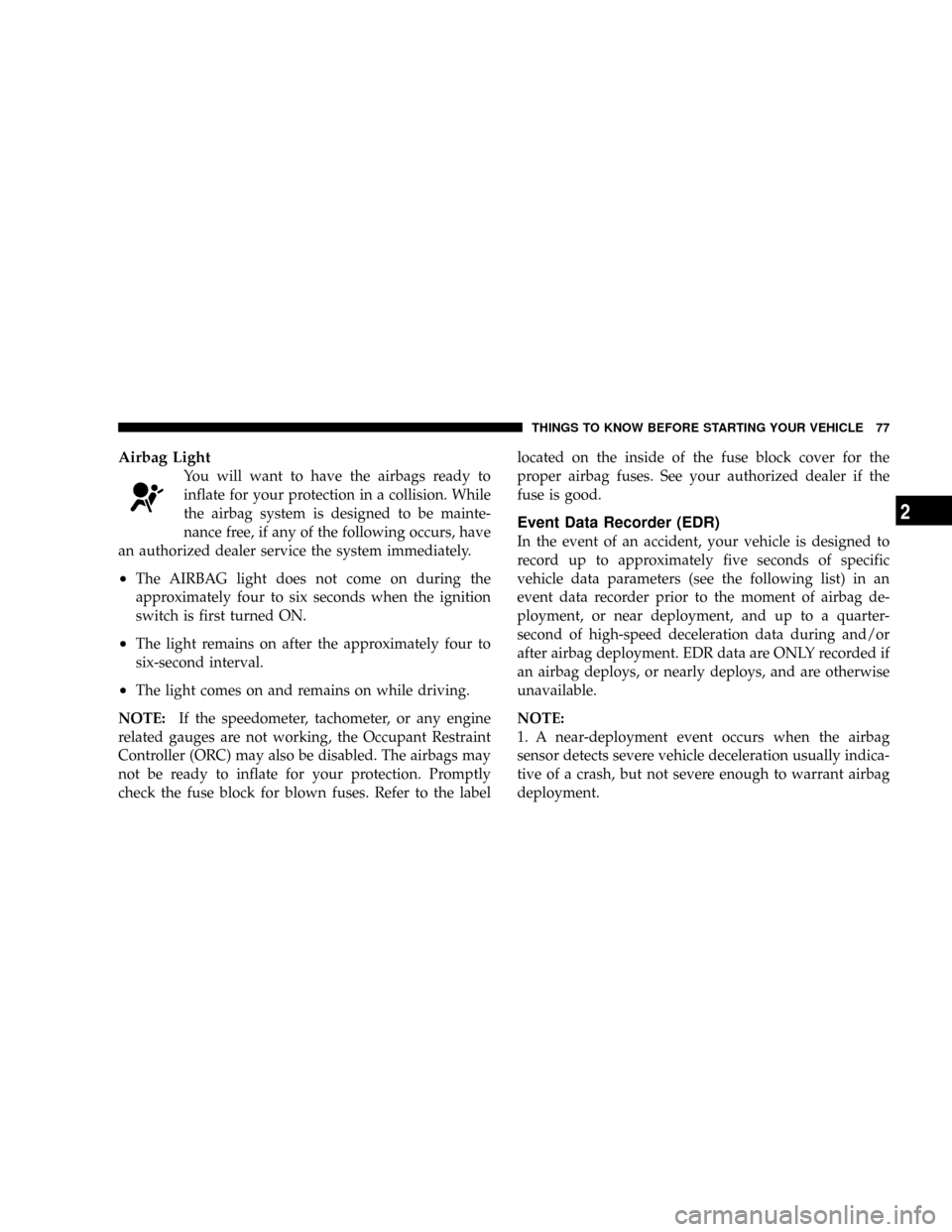
Airbag Light
You will want to have the airbags ready to
inflate for your protection in a collision. While
the airbag system is designed to be mainte-
nance free, if any of the following occurs, have
an authorized dealer service the system immediately.
²The AIRBAG light does not come on during the
approximately four to six seconds when the ignition
switch is first turned ON.
²The light remains on after the approximately four to
six-second interval.
²The light comes on and remains on while driving.
NOTE:If the speedometer, tachometer, or any engine
related gauges are not working, the Occupant Restraint
Controller (ORC) may also be disabled. The airbags may
not be ready to inflate for your protection. Promptly
check the fuse block for blown fuses. Refer to the labellocated on the inside of the fuse block cover for the
proper airbag fuses. See your authorized dealer if the
fuse is good.
Event Data Recorder (EDR)
In the event of an accident, your vehicle is designed to
record up to approximately five seconds of specific
vehicle data parameters (see the following list) in an
event data recorder prior to the moment of airbag de-
ployment, or near deployment, and up to a quarter-
second of high-speed deceleration data during and/or
after airbag deployment. EDR data are ONLY recorded if
an airbag deploys, or nearly deploys, and are otherwise
unavailable.
NOTE:
1. A near-deployment event occurs when the airbag
sensor detects severe vehicle deceleration usually indica-
tive of a crash, but not severe enough to warrant airbag
deployment.
THINGS TO KNOW BEFORE STARTING YOUR VEHICLE 77
2
Page 100 of 531
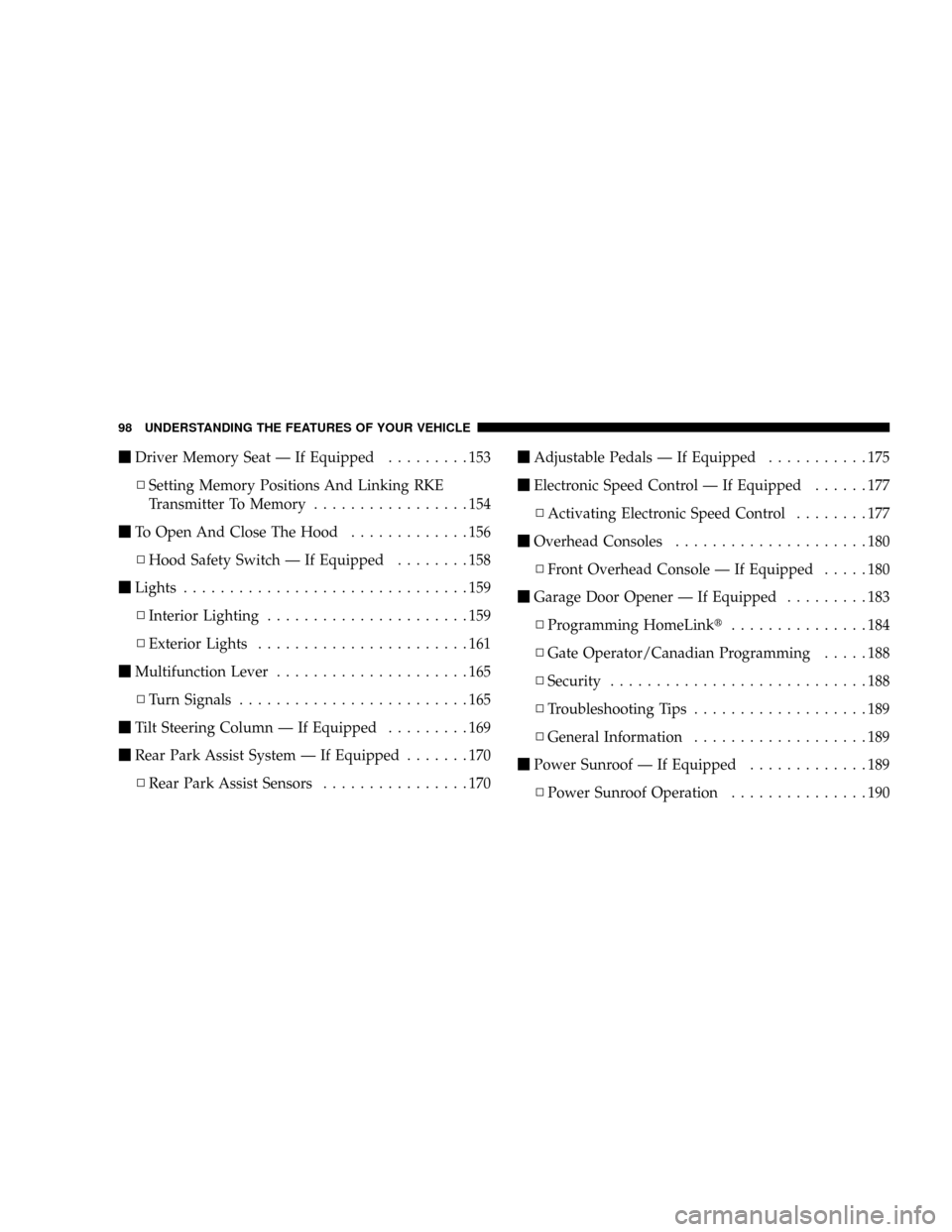
mDriver Memory Seat Ð If Equipped.........153
NSetting Memory Positions And Linking RKE
Transmitter To Memory.................154
mTo Open And Close The Hood.............156
NHood Safety Switch Ð If Equipped........158
mLights...............................159
NInterior Lighting......................159
NExterior Lights.......................161
mMultifunction Lever.....................165
NTurn Signals.........................165
mTilt Steering Column Ð If Equipped.........169
mRear Park Assist System Ð If Equipped.......170
NRear Park Assist Sensors................170mAdjustable Pedals Ð If Equipped...........175
mElectronic Speed Control Ð If Equipped......177
NActivating Electronic Speed Control........177
mOverhead Consoles.....................180
NFront Overhead Console Ð If Equipped.....180
mGarage Door Opener Ð If Equipped.........183
NProgramming HomeLinkt...............184
NGate Operator/Canadian Programming.....188
NSecurity............................188
NTroubleshooting Tips...................189
NGeneral Information...................189
mPower Sunroof Ð If Equipped.............189
NPower Sunroof Operation...............190
98 UNDERSTANDING THE FEATURES OF YOUR VEHICLE
Page 172 of 531
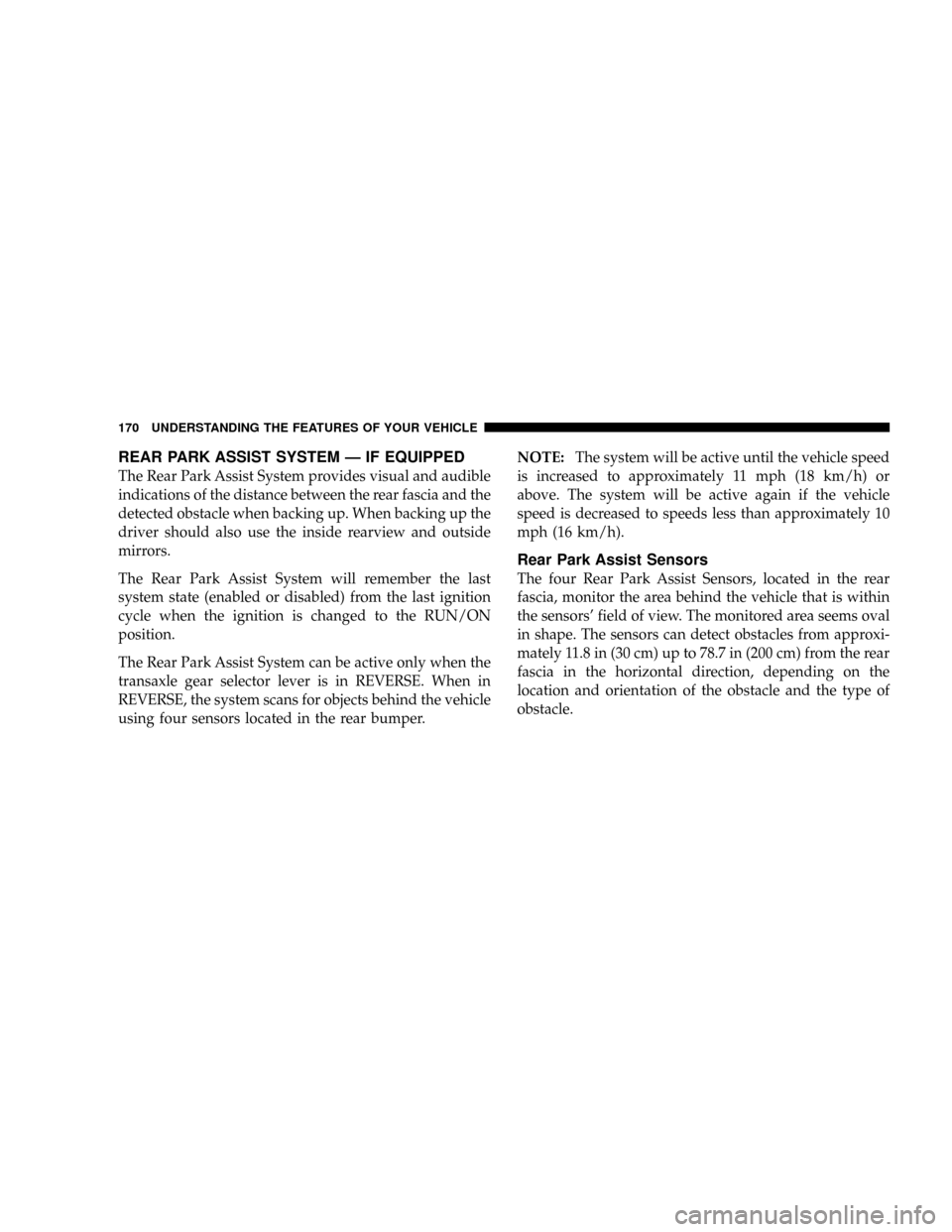
REAR PARK ASSIST SYSTEM Ð IF EQUIPPED
The Rear Park Assist System provides visual and audible
indications of the distance between the rear fascia and the
detected obstacle when backing up. When backing up the
driver should also use the inside rearview and outside
mirrors.
The Rear Park Assist System will remember the last
system state (enabled or disabled) from the last ignition
cycle when the ignition is changed to the RUN/ON
position.
The Rear Park Assist System can be active only when the
transaxle gear selector lever is in REVERSE. When in
REVERSE, the system scans for objects behind the vehicle
using four sensors located in the rear bumper.NOTE:The system will be active until the vehicle speed
is increased to approximately 11 mph (18 km/h) or
above. The system will be active again if the vehicle
speed is decreased to speeds less than approximately 10
mph (16 km/h).
Rear Park Assist Sensors
The four Rear Park Assist Sensors, located in the rear
fascia, monitor the area behind the vehicle that is within
the sensors' field of view. The monitored area seems oval
in shape. The sensors can detect obstacles from approxi-
mately 11.8 in (30 cm) up to 78.7 in (200 cm) from the rear
fascia in the horizontal direction, depending on the
location and orientation of the obstacle and the type of
obstacle.
170 UNDERSTANDING THE FEATURES OF YOUR VEHICLE